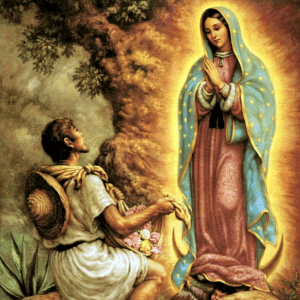
St Juan Diego was a Chichimec native peasant to whom Our Lady of Guadalupe appeared and worked miracles. He is the first canonized saint from the indigenous peoples of North America.
Read the full St Juan Diego novena on the novena page. You can also learn more about novenas here.
What Is Saint Juan Diego Known For?
Juan Diego was born with the name Cuauhtlatoatzin in 1474, in Mexico.
His father died when he was young, so he was taken in by his Aztec uncle.
Juan Diego and his wife Maria Lucia converted to the Catholic Faith and were baptized after being evangelized by the Franciscan missionary friars who came to Mexico in 1524.
He was pious in his faith and would walk long distances to be catechized by the Franciscans.
On December 9th, 1531, on his way to the Mass for the Feast of the Immaculate Conception, a beautiful lady appeared to Juan Diego and told him that she was the ever-perfect holy Mary, the Mother of God.
Our Lady told Juan Diego that her maternity extended over all the people of this land and to ask Bishop Juan de Zumarraga to build a chapel on Tepeyac Hill in her honor.
Juan Diego went on his way and informed the Bishop of Our Lady’s miraculous appearance and request, but the Bishop doubted his words.
On his way back, once again Our Lady appeared to Juan Diego, and he told her that the Bishop did not heed him for he was a poor peasant, but Our Lady insisted that Juan Diego was the man she had chosen for this task, so the next day he went back to the Bishop to repeat her request.
The Bishop this time asked for Juan Diego to provide proof that Our Lady appeared to him.
Juan Diego returned to Tepeyac Hill and Our Lady appeared to him for the third time. She told Juan Diego that she would provide the evidence the next day.
Juan Diego’s uncle fell ill though, and he had to take care of him, so he was unable to go back to Tepeyac for the proof.
The following day, December 12th, Juan was rushing to find a priest to attend to his uncle and he attempted to skirt the Hill to avoid Our Lady, ashamed that he missed yesterday’s appointment.
Our Lady appeared to him anyway and spoke the words that are found at the beginning of the novena prayer below.
She assured Juan Diego that God would heal his uncle and then directed him to pick the roses he would find at the top of the Hill (remember this is late autumn).
Juan Diego obeyed and found many flowers in full bloom on the rocky hilltop, picking them and putting them in his tilma (a long cloak).
Our Lady of Guadalupe then personally arranged the flowers in his tilma and told him to go to the Bishop immediately, which he did.
Juan Diego let fall the flowers from his tilma in front of the Bishop, and the Bishop at once fell to his knees, seeing in the tilma a perfect image of Our Lady impressed upon the tilma.
When Juan Diego returned to his sick uncle, he found him completely healed, just as Our Lady promised. And his uncle told him that she had appeared to him, too.
Our Lady wanted a church built on Tepeyac Hill and that she was to be referred to as Our Lady of Guadalupe.
The Bishop consented and had a chapel built on Tepeyac the following year, placing the miraculous tilma in it.
During the first procession up Tepeyac, a member of the faithful was shot by an arrow in the throat, and was dying, but then was miraculously healed when placed in front of the tilma.
St Juan Diego went to live in a tiny cell on Tepeyac and lived a humble life of prayer. He died on December 9th, 1548, exactly 17 years from the first appearance of Our Lady of Guadalupe to him.
Our Lady’s appearance and miracle led to the mass conversion of the Aztecs to Christ and His Church, to the tune of thousands per day, and many millions over the course of the following years.
The tilma, which should long ago have decayed, being made of organic material, remains perfectly preserved to this day in the Basilica of Guadalupe in Mexico, in spite of a bombing of the building.
St Juan Diego was beatified on May 6th, 1990 by Pope John Paul II St Juan Diego was canonized on July 31st, 2002, also by Pope John Paul II.
He is the patron saint of the indigenous people of the Americas.